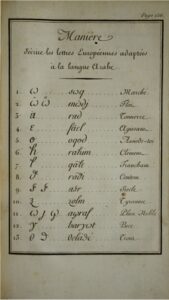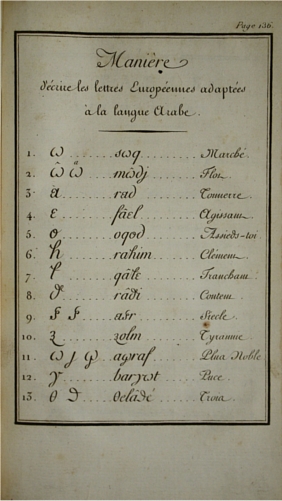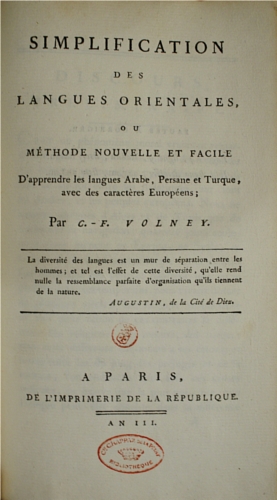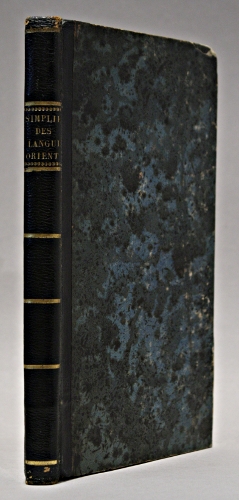Paris, Imprimerie de la République, An III (1795).
8vo [216 X 127 mm] of 135 pp. and 4 plates out of pagination including 3 folding plates.
Black half-morocco, flat spine decorated with flat bands, yellow edges, (two rounded corners). Contemporary binding.
First edition of the earliest Arabic grammar written in French.
When he was 20, Volney devoted himself to the study of history and ancient languages. A six thousand books inheritance falling to him, he decided to go and visit Egypt and Syria in 1783.
Once in Egypt, he retreated into a Coptic convent for eight months to learn Arabic.
The « Traité sur la simplification des langues orientales » published in 1795, is the earliest treatise dedicated by Volney to his great works about this theme which will make him famous.
The epigraph, extracted from the Cité de Dieu of St Augustine, gives a sufficient idea of the book’s subject: “the variety of languages, said this Father of the Church, is a dividing wall between men; and the effect of this diversity is that it annuls the perfect similarity of organization that they got from nature.” The preliminary discourse is considered as a model of style, and Volney whose wide mind considered all the questions from an elevated point of view, was predicting from that moment on the complete subversion of the European colonial system, the emancipation of all America and the formation of new States intended to compete with the old ones on the Atlantic.
Considering this truth that the various signs of language have to represent the various sounds, Volney had conceived the project of a single alphabet. The means consisted in adding a few indispensable signs to the Roman alphabet and to apply it to Asian languages. This unity of alphabet was already taking away a difficulty to study them. Besides, Volney wanted to apply to eastern idioms a part of grammatical notions that we got from European languages. Making easier the study of Asian languages, he was planning to improve the business relations. It was already a big political project, but he was also seeking in the analytical study of those languages a new way to go back to the origin of the oldest nations. He claimed, according to the different characters of their idioms, to judge their knowledge of morality, legislation, literature; because the signs admitted by a nation in its language are necessarily the ones of its ideas.
The treatise contains 4 plates out of pagination illustrating the Arabic alphabet in the common order, the Arabic alphabet transposed in European characters for the use of travellers (400 x 310 mm), the conjugations and the way to describe European letters adapted to Arabic language.
An attractive copy of this philology work important for its precocity, in perfect original condition.
It comes from the collection of the count and countess Chappaz de La Prat with ex-libris with arms on paste-down, and two red owners’ stamps.




